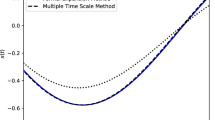Abstract
This paper introduces and illustrates the stabilization principle that provides a strategy for modeling post instability behavior in dynamics, including turbulence and chaos. It starts with investigation of different types of instability with the objective to demonstrate that stability is not a physical invariant since it depends upon the frame to which the motion is referred, upon the class of functions in which the governing equations are derived. The application of the stabilization principle to the Navier–Stokes equations is illustrated by closure of the Reynolds equations for the Poiseuille flow.






Similar content being viewed by others
References
Lurie AI (2002) Analytical mechanics, chapter 6, section 6.1. Springer, New York
Zak M (1970) Uniqueness and stability of the solution of the small perturbation problem of a flexible filament with a free end. PMM (Prikladnaya Matematika I Mekhanika) 39:1048–1052
Zak M, Meyers RE (1996) Non-Newtonian effects in viscose flows. Int J Theor Phys 35(7):1423–1460
Zak M (1994) Postinstability models in dynamics. Int J Theor Phys 33(11):2215–2280
Lessen M, Paillet F (1976) Marginal instability of turbulent shearing layers and the break point of a jet. Phys Fluids 19:943–944
Drazin P, Reid W (1984) Hydrodynamics stability. Cambridge University Press, New York
Arnold V (1988) Mathematical methods of classical mechanics. Springer, New York
Reynolds O (1895) On the dynamical theory of incompressible viscous fluid and the determination of the criterion. Philos Trans R Soc Lond Ser A 186:123–164
Zak M (2009) Turbulence revisited. Chaos Solitons Fractals. 41:1136–1149
Zak M (1986) Closure in turbulence theory using stabilization principle. Phys Lett A 118:139–143
Zak M (2012) Correction to Euler’s equations and elimination of the closure problem in turbulence. AIP Adv 2:042123
Author information
Authors and Affiliations
Corresponding author
Appendix: Comments to Lagrangian turbulents
Appendix: Comments to Lagrangian turbulents
The Lagrangian turbulence is defined as postinstability motion of individualized trajectories of a fluid generated by a laminar flow. A Lagrangian description of turbulence (L-turbulence) has advantage over Eulerian description of turbulence (E-turbulence) in case of studies of mixing and dispersion. That includes mixing of passive scalars and the dispersion of contaminants.
The Lagrangian description of motion starts with the frame of reference that is frozen at the fluid and moves with it. Initially, at \(t_{0} = 0\), such frame can be represented by Cartesian axes \(X_{0}\), \(\hbox {Y}_{0}\), and \(\hbox {Z}_{0}\).
For t > 0, these axes, in general, transform into a non-orthogonal curvilinear system. Any individualized particle of the fluid with the coordinates x\(_{0}\),y\(_{0}\), and z\(_{0}\) will have the same coordinates in the moving frame, but different coordinates in the initial frame
Equations (104)–(106) represent the Lagrangian description of a continuum, including fluid. These equations can be obtained as the solution of the governing equations of the fluid
presented in the Lagrangian form
This is a system of four PDE with respect to four unknowns: x,y,z and p as functions of \(\hbox {x}_{0}, \hbox { y}_{0,}\hbox { z}_{0}\) and t.
However if the Euler’s equations (107)–(110) are already solved in the form
then the Lagrangian description of the same motion reduces to three kinematical ODE
to be solved subject to the following initial conditions
The solution of this system can be written in the form (104)–(106).
It should be emphasized again that Eq. (116) are kinematical, and they are valid not only for the Euler incompressible fluid, but for a viscose compressible fluid as well. The only difference is in the form in which the velocities as known functions of the coordinates are presented in Eqs. (116).
Comparing the Eulerian and Lagrangian descriptions of fluid motion, one sees that Lagrangian description requires an additional system of differential equations (116), and that can change the condition of stability of the solution (116) even if the solutions (115) are stable. Indeed the chaos in the systems of the first order ODE can appear when \(n\ge 3\),where n is the number of equations. Since \(n =3\) in Eq. (116), a laminar flow of a fluid can have chaotic trajectories, and that we will call Lagrangian turbulence.
The first theoretical example of Lagrangian turbulence was introduced by Arnold [7] who proved that an inviscid stationary flow with a smooth velocity field
has chaotic trajectories that represent Lagrangian turbulence. It means that this flow is stable in the Eulerian coordinates, but is unstable in the Lagrangian coordinates. Actually this result is another evidence of the statement made in Sect. 2 that stability is not a physical invariant: it depends upon the frame of reference.
Rights and permissions
About this article
Cite this article
Zak, M. Stabilization principle in dynamics: a tutorial. Int. J. Dynam. Control 5, 407–420 (2017). https://doi.org/10.1007/s40435-016-0254-x
Received:
Revised:
Accepted:
Published:
Issue Date:
DOI: https://doi.org/10.1007/s40435-016-0254-x




